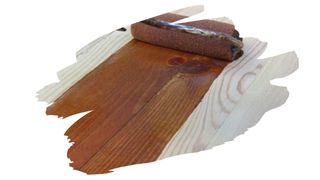Danish oil is probably one of the most popular wood finishes you can use on interior wooden furniture. It is a fast drying top coat. And, it’ll cure in a fraction of the time of other finishes such as Linseed oil or Tung oil.
And as a penetrating oil based finish, it’ll also sink right down into wood grain, enhancing the look of timber from the inside out.
But, what if you want to change the color of that Danish oil coat in and of itself?
Well, in this post, you will find out what you can do to add color to Danish oil — even after it’s been applied and dried. You’ll also learn why binders found in wood stains can be a problem when it comes to mixing stain with oil.
And keep reading to discover the simplest way to blend Danish oil, so you can get just the right color for you.

This post may contain affiliate links to products that we receive a commission for (at no additional cost to you). Learn more here.
Can You Add An Oil Based Wood Stain To Danish Oil?
If you’re thinking of coating wood stain over Danish oil, then no, it won’t work.
Penetrating wood stains work in a somewhat similar fashion to oil based finishes like Danish oil. You apply them onto the surface of wood, and then they sink down into wood pores, adding color to wood fibers.
And, Danish oil does something very similar. This oil finish will sink down into wood and enhance it from the inside out. But, with one extra step; it’ll thoroughly seal over those wood pores and leave a thin resin film on the surface.
So, placing a penetrating wood stain over Danish oil means that the wood stain will turn out blotchy. And that is because it can’t evenly sink down into the wood underneath.
Related Post: Can You Stain Over Oiled Wood? (The Top 5 Oil Finishes Examined)
And What About The Reverse? Can You Put Danish Oil Over Stain?
You could, but it won’t be able to sink into the surface of wood evenly either.
You see, wood stains are made up of two main things; pigments and binders. The pigments add the color, and the binder keeps that color in place.
Now, depending on which stain you’ve purchased, it’s binder ingredient can be something like varnish, linseed oil, or even polyurethane. And all of those binders means that wood stain can often end up sealing over wood pores too.
Now, wood stain isn’t as good at sealing over those wood pores as Danish oil, obviously. But, wood stains binder ingredient can still prevent Danish oil from leaving behind an even finish.
Related Post: All About Danish Oil: Advantages and Disadvantages
So, Can You Mix Danish Oil And Stain Together Instead?
As a general rule of thumb, no you can’t. And this is because of the drying time of the binder used in the wood stain.
When you mix Danish oil with Wood stain, you are mixing two different products with two very different drying times.
For example, wood stains that use varnish as a binder can dry in 2-6 hours. While Danish oil finishes often need around 24-48 hours to properly dry between coats.
And by combining these two products together, you’ll end up messing up their drying times altogether.
So, a first coat of Danish oil / Stain mix will coat on fine. But, subsequent coats of this finishing recipe are more likely to look increasingly uneven.
Related Post: Should You Use A Hard Wax Oil Finish Vs Danish Oil?
So, How Do I Add A Bit More Color To Danish Oil?
Well, if you haven’t already applied that oil, then you can mix different tinted Danish oil finishes together.
Provided they are both from the same brand, they’ll have the same drying times. So, you can blend them together to get the color you want.
This is the easiest way to mix Danish oil to personalize the color to your own tastes.
Help! I’ve Already Applied The Danish Oil! What Can I Do Now?
Okay, first off don’t panic. You can still salvage things by simply using an alternative wood stain product called ‘gel stain’.
Gel stains add color to wood much the way that paint does. It does not need to sink into wood grain, because gel stains sit on the surface of wood.
However, by using a transparent gel stain, you aren’t really changing the color of Danish oil in and of itself. Rather, you are painting over it, but all without masking the wood’s texture underneath.
And How Long Should You Wait Before You Apply Gel Stain Onto Danish Oil?
Wait for the Danish oil to wholly cure first before applying anything — including gel stain — over it. Danish oil can dry in a day or so, but it can take a few days to cure.
A dry Danish oil is when this oil turns from a liquid into a solid (but still soft) film. And it can still feel dry to the touch at this stage.
Related Post: Danish Oil Not Drying? What You Need To Know To Avoid Disaster!
However, you should not apply the gel stain yet. Instead you should wait for Danish oil to go through a chemical reaction called ‘curing’.
That cured reaction turns Danish oil from a film into a final hard resin coat. And at this point, you can go ahead and use gel stain on it.
To Sum Up, Here Are The 3 Main Takeaways From This Post…
- 1). An oil-based wood stain should not be mixed with Danish oil. That is because the drying time of wood stain will clash with the drying time of Danish oil.
- 2). Their mismatched drying times can also make subsequent coats (of their combined blend) dry unevenly.
- 3). If you want to change the color of Danish oil, simply blend it with another tinted Danish oil finish.



